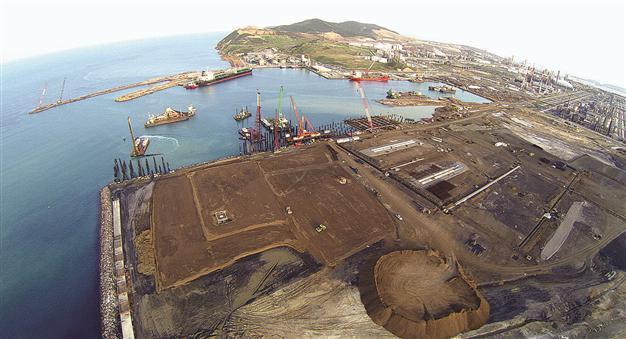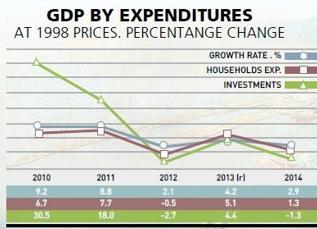Turkish business world in panic over contraction in economic growth
Mustafa Sönmez - mustafasnmz@hotmail.com

Turkish refinery giant Petkim’s facility is seen in this aireal photo. CİHAN photo
“If the GDP growth slows down in the first quarter and a significant recovery cannot be maintained in the following quarters, 2015 will be a year during which Turkey grows below its potential. This really matters, as we all know. The GDP growth has been slowing down since 2011 and the country has already been growing under its real potential. I call this ‘the inability to grow,’” said one of Turkey’s most prominent economists, Prof. Taner Berksoy, in his April 1 column in the Turkish daily Dünya.This “inability to grow,” in Berksoy’s terms, has caused a feeling of panic among businesspeople, especially when they saw the GDP growth data for 2014…
Targets could not be met in 2014
The Turkish Statistical Institute (TÜİK) announced the GDP growth rate for 2014 as 2.9 percent upon fixed prices on March 31. The GDP grew 2.6 percent in the last quarter of 2014, according to the TÜİK data. There was some shrinkage in the added value of the agricultural sector at around 2 percent and in total investments at around 1.3 percent. Industrial production grew by 3.5 percent and the services sector by 4 percent in 2014.
The national income contracted by some $23 billion in 2014. Turkey’s national income, thus, decreased to $800 billion and the income per-capita by $418 with the latest updates. The income per capita fell to around $10,404 in 2014, compared to $10,822 in 2013.
While investments upon fixed prices fell by 1.3 percent in 2014, household consumption expenditures rose by 1.3 percent. Some 1.9 percent of the 2.9 percent of the GDP growth came from the rise in exports. However, exports were not enough to boost the growth rate in a year when the U.S. dollar gained over 15 percent value against the Turkish Lira.
The growth target, which had been set at 4 percent earlier, was revised to 3.3 percent in mid-2014, but the real rate was announced even below the revised target.
 Shrinkage in 2015
Shrinkage in 2015The 2014 growth rates were far from being satisfactory. What about 2015? In the medium-term economic program, the growth target was set at 4 percent for 2015. Some zero growth is, however, expected in the first quarter of 2015.
Fresh data from the TÜİK has shown the country’s foreign trade deficit narrowed by 10 percent in February from the same month of the previous year, but the data does not point to an improvement since it was engineered by a drop in imports rather than an increase in foreign sales.
Turkey grew lower than 3 percent in the last three years and business circles are concerned about the process, urging Turkey to write a new growth story.
Key warnings from TOBB head
Union of Chambers and Commodity Exchanges (TOBB) head Rifat Hisarcıklıoğlu made key warnings about the economy and said the GDP growth had been slowing down recently, but the current account gap had increased for the last few years.
He said the current account gap-to-GDP averaged 4.5 percent between 2003 and 2007, with a GDP growth rate at around 6.9 percent. Although the former figure increased to 7.1 percent between 2010 and 2014, the GDP growth average decreased to 5.4 percent, he said.
“We have fallen into the middle income trap. Our national income has remained at the same level since 2008… The welfare per-capita has not been rising as no structural reforms are made. We need to stop being lost in the middle of empty daily discussions and focus on making reforms. Otherwise, it will be no good to us,” Hisarcıklıoğlu said at a meeting of the Economy Journalists’ Association (EGD).
Hisarcıklıoğlu said businesspeople have had problems with cash proceedings for the last four months and the number of rubber checks increased by 3.7 percent this year from the first months of the previous year. He also noted many exporters have faced problems too, as they purchase goods in advance, but sell their goods on credit. Only 9 percent of exports are made in cash, whereas the number of imports made in cash is around 49 percent, said Hisarcıklıoğlu.
Employers’ union has no hope for 1st quarter
The Turkish Confederation of Employers’ Unions (TİSK), the top body for employers’ organizations, also voiced its concerns over Turkey’s recent “inability to grow.” In a written statement, TİSK said the industrial sector has been irritated and losing power. The organization noted industrial production decreased in January for the first time in the last four years, causing shrinkage in company revenues and the use of production capacities. “The signs of economic recession and of distrust have been increasing,” read the statement. The organization said there was a 2.2 percent decrease in industrial production on an annual basis. “The revenues have been decreasing and the capacity utilization rates fell to 72.4 percent by the end of March. The recent data does not give hope about the growth rates in the first quarters,” said the statement.
Criticism from top bosses
A number of leading businesspeople have also recently voiced their concerns about the economy, including Akbank Chairperson Suzan Sabancı Dinçer and Anadolu Group Chair Tuncay Özilhan, one of the former presidents of the top business organization, TÜSİAD.
Özilhan said the GDP growth of the country has been slowed by the government on purpose in recent years to ease the current account gap.
“Turkey could solve its unemployment problem as long as it could grow by and above 7 percent. The problem remains unsolved with any growth rate below this. We see this is happening now as the unemployment rate surpasses 10 percent,” he said.
Özilhan emphasized the Turkish economy’s biggest problems are the chronic current account gap and the resulting saving gap, but no robust steps have been taken to solve these problems for years. “The higher the current account gap, the more need the authorities feel to put on the breaks in the economy. When the current account deficit decreases, the whole economy reaches a balancing point, but unemployment increases at this point. Investments that will decrease the current account gap needs to be supported. The existing incentives are not enough to meet this goal,” Özilhan said.
“Politics comes before economics right now. Economics needs to get ahead of politics, appearing in headlines more and being administered better than it is now. We see some disorganization in the administration of the economy. Everybody focuses on the June elections now…After the elections, [Deputy Prime Minister] Ali Babacan may not be leading the economy team. We do not know what will happen then,” he added.
The Banker Magazine gave a place to Dinçer’s comments about the Turkish economy and the banking sector in its April issue. She said savings decreased by around 51 percent, but the growth in loan rates increased. Dinçer said the saving rates have now regressed to around 12-14 percent, from around 23.5 percent in the 1990s.
Dinçer said higher loan-to-deposit rates will constitute a new obstacle for the banking sector.
“The oil slump may help Turkey to improve its current account figures, but what Turkey needs is to encourage its citizens to save more to be able to grow steadily in the long-term,” Dinçer said.
Confidence decreasing
Deteriorating “confidence indexes” have also caused the country’s business circles to have and voice concerns about the sustainability of the Turkish economy. The consumer confidence index decreased in March by 5.4 percent from the previous month. The real sector’s confidence index decreased from 104 to 100.9, the services sector’s confidence index from 101.86 to 101.25 and the retail sector’s confidence index from 103.4 to 102.97. The construction sector’s index regressed to 83.67 in March, a 1.6 percent decrease from the previous month.
The economic confidence index decreased to 74.85 points in March, a 15.4 percent decrease from the previous month. According to the TÜİK statement, the decrease in the economic confidence index was a result of decreases in the confidence indexes of the manufacturing, service, retail and construction sectors.
The economic confidence index indicates an optimistic outlook about the general economic situation when the index is above 100 and a pessimistic outlook when it is below 100.
Critics come together under the following motto upon all this data: “We need a new growth story.”
That is true, but how? This is the greatest question and we need to find an answer...
















